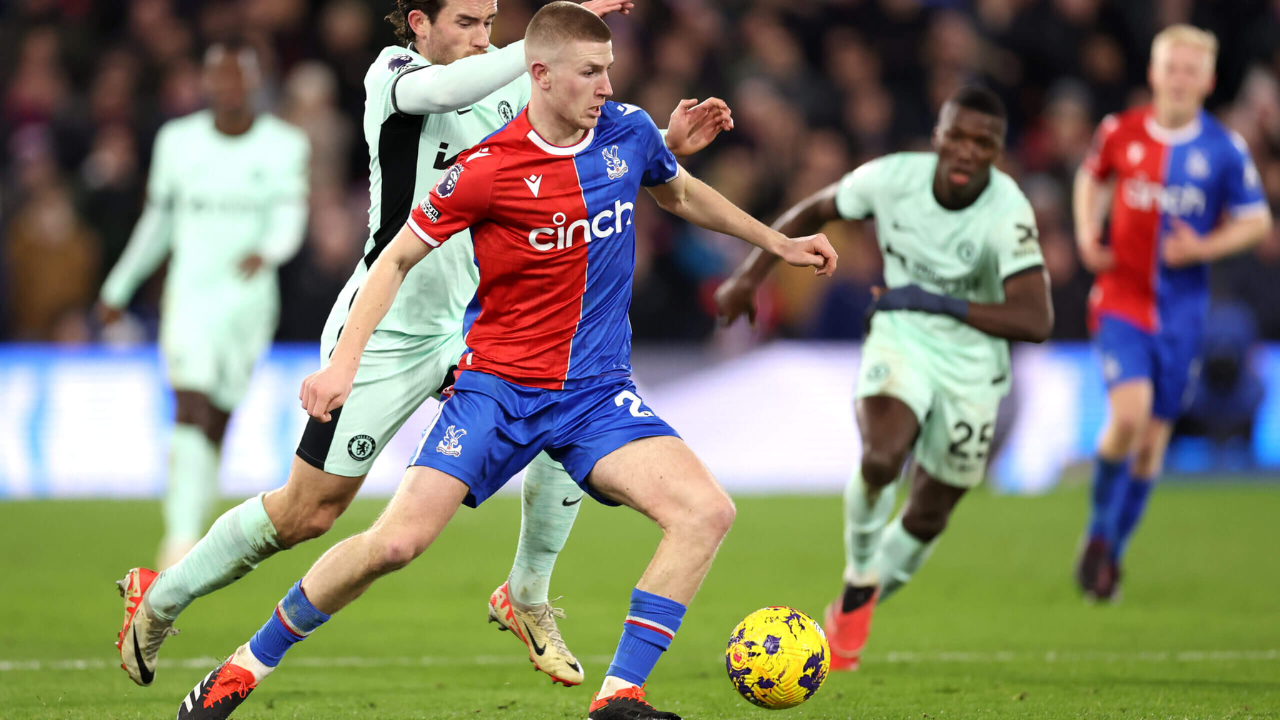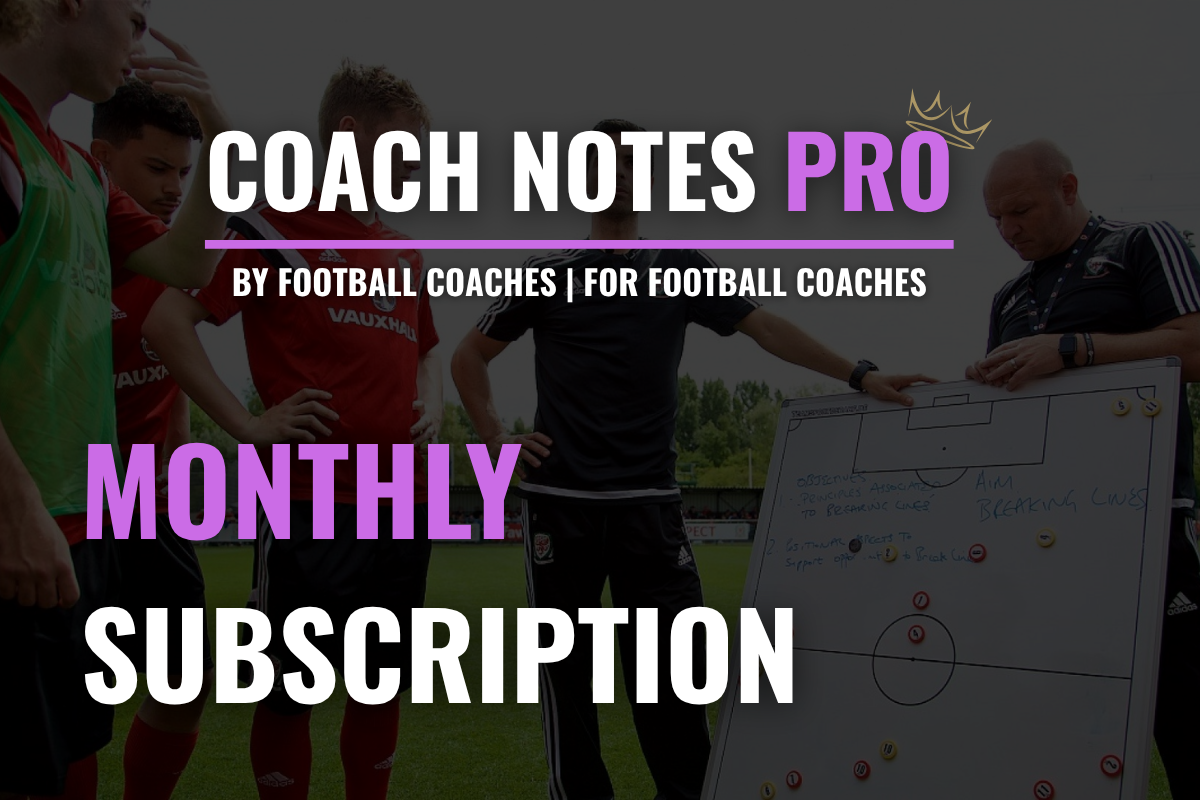
Defensive/Deep-Lying Midfielder Specific Coaching
This section features 8 key areas essential to developing defensive & deep-lying midfielders, each with tailored coaching tips and position-specific drills. Every skill is broken down to help strikers make better decisions and execute with confidence in 1v1 situations.
Screening & Intercepting Coaching Tips
✅ Prioritise Position Over Pressure
A deep midfielder’s primary role is to screen space, not chase the ball. Teach players to adopt a disciplined starting position in front of the centre backs, staying goal-side of the ball and between the lines. Their job is to block central passing lanes and force play wide, not to engage too early. Emphasise restraint, intelligent positioning cuts off more danger than aggressive pressing in this role.
✅ Master the Art of Scanning & Body Orientation
Effective screening begins with constant scanning. Players should check over both shoulders before and after every movement to track runners and anticipate passes. Their body orientation should stay half-turned, allowing them to see both the ball and potential threats behind them. Drills should encourage receiving or defending with limited visual cues to simulate real match demands.
✅ Intercept Through Anticipation, Not Reaction
Interceptions are won with anticipation, not speed. Encourage players to “read” the ball carrier — their body shape, eyes, and preferred foot — to predict where the next pass will go. Once they recognise a pattern, they should step in decisively, not hesitantly. Use live pattern drills or rondos with specific triggers (e.g. locked hips or inside passes) to help players read these moments.
✅ Stay Connected to the Back Line & Pivot Points
Teach defensive midfielders to constantly adjust their positioning based on the location of the ball, centre backs, and nearest central midfielder. If the line of pressure is broken, they must drop quickly to screen the space in front of the penalty box. When play is wide, they must protect the zone between the full-back and centre back. Encourage “checking distances” regularly to avoid being caught too high or flat.
✅ Control the Tempo of Defensive Moments
Good screeners dictate when and where duels happen. Players should be coached to delay attacks when outnumbered or exposed by holding their line and using their body to shepherd the play. They must know when to press the touch, when to delay, and when to step in. Use scenarios in training where players defend in 1v2 or 2v3 situations to reinforce calmness and timing under pressure.
Tackling & Ball-Winning Coaching Tips
✅ Timing Over Aggression
A well-timed tackle beats a reckless one every time. Defensive midfielders should be taught to delay and contain before committing to a challenge. Rushing in often leads to being bypassed or giving away fouls. Use 1v1 isolation drills where the midfielder is rewarded for forcing errors or delaying, not just winning the ball. Emphasise timing the tackle as the attacker makes their touch, not before.
✅ Stay Low & Balanced in Duels
Teach players to adopt a low, athletic stance — knees bent, body slightly forward, arms out for balance. This allows for quick lateral movement, sudden bursts, and recovery if beaten. Tackling while off balance often leads to poor execution or fouls. Include agility-based defensive drills that reinforce reactive footwork and body control in tight spaces.
✅ Identify Zones to Tackle vs. Zones to Delay
Not all areas are equal. Defensive midfielders should be coached to delay and jockey in central areas or in front of the back line, but be more aggressive when pressing near the touchline or higher up the pitch. Use zonal pressing grids in training to reinforce where and when to commit to a tackle, encouraging situational decision-making.
✅ The Pass After the Tackle
Ball-winners must transition from defence to possession instantly. Stripping the ball is only the first part — the second is making a simple, clean pass to retain it. Drills should focus on winning the ball and playing forward under pressure, simulating live counters. Emphasise first-pass accuracy after the duel to complete the defensive action with control.
✅ Use Tackling Techniques to Fit the Scenario
Teach a range of tackling techniques — front foot poke tackles when pressing from behind, block tackles in close duels, and slide tackles as a last resort. Players should understand when and how to apply each based on distance, angle, and urgency. In training, use constraints (e.g. touch limits or opponent overloads) to push players into making live decisions about tackle choice.
Receiving Under Pressure Coaching Tips
✅ Scan Relentlessly
Elite press-resistant players scan up to 6–8 times before receiving. Deep midfielders must develop the habit of checking their shoulders to spot pressing opponents, free teammates, and space. This scanning should continue while the ball is en route to make real-time adjustments. Use rondo-based drills with late pressure to encourage this behaviour — and freeze play to reinforce positive scanning habits.
✅ Use the First Touch to Escape Pressure
Receiving under pressure isn’t just about ball control — it’s about using the first touch to create time and space. Train players to manipulate the ball away from pressure using the back foot, outside of the foot, or a disguised cushioned touch. Include unannounced pressure in drills to force quick reactions, ensuring the first touch breaks the initial press line.
✅ Body Shape Dictates Options
Teach players to receive side-on with a half-turn body shape, which allows quicker turning and gives access to more passing lanes. Being square to the ball increases the risk of being pressed from behind. Sessions should emphasise body orientation as a decision-making tool — when to open up, when to shield, and when to bounce a pass backwards to retain possession.
✅ Develop Calmness in Chaos
Confidence under pressure is a learned behaviour. Simulate chaos in training with tight spaces, limited touches, and passive to active pressing escalation. Encourage players to resist the instinct to panic, using disguise, feints, or small direction changes to manage space. Psychological calmness is as important as technical skill — encourage players to embrace pressure as part of their identity.
✅ Think One Step Ahead
Press resistance is not about reacting fast — it’s about anticipating. Players should be coached to recognise where the next pass will go before the ball arrives. Use pattern drills and “play out of pressure” exercises where midfielders are tasked with receiving and immediately playing out of pressure based on triggers. Reinforce that escape is not always forward — it can be sideways or back to reset the build.
Switching & Breaking Lines Coaching Tips
✅ Head Up Early – Recognise Triggers Before the Pass
Train players to lift their head before receiving to identify whether the opposition block is narrow, stretched, or leaving gaps. Scanning wide early helps them spot full-backs or wingers isolated on the far side. Use scenarios where the midfielder has 2–3 passing options and must read which is most advantageous before the ball arrives.
✅ Break Lines When the Opponent is Disorganised
Line-breaking passes are most effective just after a turnover, when the opposition is in transition or shifting horizontally. Encourage midfielders to play forward as a priority — but only when the receiver is in a good body position to progress. Use drills that involve midfielders threading passes into pockets between midfield and defence with moving targets to train vision and precision.
✅ Use Tempo Changes to Unbalance the Block
A smart deep midfielder doesn’t always pass quickly — they invite pressure to create space elsewhere. Encourage players to hold the ball briefly at times to draw in opponents, then switch with speed. Play 4v4+3 possession games where the switch is rewarded, forcing the central pivot to dictate when to go fast or slow.
✅ Switch With Purpose, Not Just Distance
Switching play isn’t about hitting long diagonal balls aimlessly — it’s about shifting the opposition to exploit weak-side space. Teach players to recognise when the far-side winger or full-back is isolated and how to find them with accurate aerial or driven passes. Use pattern drills with a wide overload to reinforce hitting the weak side on the second or third phase.
✅ Master Multiple Passing Techniques
Breaking lines and switching play require a versatile passing toolbox. Train short, disguised reverse passes into pockets; lofted passes over a press; and long, flat diagonals. Each technique suits a different situation. Include situational rondos or positional play exercises where players must use at least two types of pass under pressure within a sequence.
Build-Up Play Coaching Tips
✅ Constantly Adjust Position to Provide an Angle
Defensive midfielders must never be static in the build-up phase. Teach them to continually shift their position to offer diagonal angles to both centre backs and full backs. Encourage movement that opens passing lanes between pressing opponents and supports play on both strong and weak sides. Use positional rondos where the midfielder must constantly re-position to receive.
✅ Receive Facing Forward When Possible
Receiving side-on allows the midfielder to see the pitch and play forward in one motion. In tight situations, it may be necessary to bounce the ball back, but the default should always be to open the body and progress play. Drills should reinforce turning on the half-turn and playing vertically when the opportunity is there.
✅ Drop Into the Back Line When Pressed High
Coaching midfielders to recognise when to drop into a back three is vital. Against an aggressive press, stepping into the defensive line (between or beside the centre backs) can create overloads and new passing angles. Train this movement through build-up shape patterns and trigger recognition (e.g. when full backs push high or the opponent presses 2v2).
✅ Keep Tempo High with Minimal Touches
Supporting the build is not just about receiving — it’s about circulating the ball efficiently. Encourage two-touch play in low-risk areas and teach players to recognise when a one-touch bounce or third-man run can break pressure. Use time-limited drills or touch-restricted phases to reinforce clean, fast distribution under pressure.
✅ Connect Defence to Midfield
Once the ball progresses, the midfielder must reposition quickly to offer a second support line behind play. Supporting the build-up means not only linking defence to midfield but also creating a reliable outlet for recycling possession. Use drills where, after connecting play, the midfielder must move to a new supporting zone (zone 14, half-space, or outside shoulder of an 8).
Decision Making Coaching Tips
✅ Maintain a Balance
In attacking phases, holding midfielders must resist the urge to vacate their zone unnecessarily. Emphasise the importance of maintaining central balance rather than chasing the ball. Use positional games with clear zones and consequences for over-committing to reinforce the concept of anchor discipline.
✅ Read Rotations & Adjust Accordingly
When full-backs, 8s or wingers rotate positions, the defensive midfielder must cover the vacated space and maintain shape. Use training patterns that simulate overlapping and underlapping movements, requiring the 6 to make split-second decisions on when to hold, slide across, or drop deeper to screen.
✅ Recognise When to Step vs. When to Sit
Players must learn to differentiate between pressing triggers (e.g. poor first touch, backward pass) and moments where holding their position is tactically superior. Develop decision-making in drills with variable pressing cues and delayed pressure to force analysis before action.
✅ Maintain Connection With Centre Backs and 8s
Teach players to constantly adjust their positioning based on the location of the nearest centre back and interior midfielder. A good defensive midfielder maintains triangular distances that allow for pressing, covering, or recycling. Use shape-focused build-up games to encourage spatial awareness.
✅ Scan for the Next Phase
Good decision-making comes from anticipation. Train midfielders to scan not only the immediate play, but also what second-phase movements may develop — such as overlaps, switches, or counter threats. Build this into attack-to-defence transition drills where the 6 must reposition before the ball is lost.
Transitional Moments Coaching Tips
✅ Immediate Reaction is Key
The first 3–5 seconds after possession loss are critical. Train defensive midfielders to instinctively react with urgency by closing the ball, delaying the counter, or recovering central ground. Build this reflex with transition-trigger drills where players must immediately switch from attacking to defending when play turns over.
✅ Regain Compactness
The priority isn’t always to win the ball back instantly, but rather to restore defensive structure quickly. Encourage midfielders to delay the opponent’s counter while teammates recover. Use counter-starting drills where the midfielder must delay attackers in 2v1 or 3v2 transitions to buy time.
✅ Prioritise Protecting Central Zones
Train the midfielder to sprint back into the “red zone” (central channel in front of the back four) as their default response if they’re caught high. Even if they’re not the first presser, re-establishing presence in central areas is key to cutting off dangerous transitions. Use pitch markings to visually define this area and reinforce its priority.
✅ Read Cues – Anticipate Before Possession is Lost
A great defensive midfielder senses when a risky attack is likely to break down. Coach players to read triggers like overhit passes, poor touches, or isolated teammates, and begin to adjust positioning slightly earlier to stay ready. Use video analysis and freeze-frame scenarios to sharpen pre-transition awareness.
✅ Force the Counter Wide
Teach midfielders how to shape their recovery runs and body orientation to guide counter-attacks toward the touchline. This reduces the threat level and gives defenders time to recover. Include drills with “kill zones” (channels where counter attacks must be forced) to instil directional control in transition moments.
Dictating Play Coaching Tips
✅ Control Tempo Through Touch Count
Teach players to use the number of touches to manipulate tempo. One-touch to increase pace, two-touch to control, and three-touch or more to invite pressure and open space elsewhere. In training, vary touch constraints based on tactical scenarios to help players develop a feel for tempo changes and when to accelerate or slow the game.
✅ Scan Early, Scan Often – Create a Picture Before the Ball Arrives
Scanning must be frequent and purposeful. Players should check for teammate positions, opposition shape, pressing triggers, and space to exploit. Train midfielders to scan before receiving, after receiving, and before releasing. Include exercises with visual cues (e.g. mannequins or cones) that change shape mid-drill to reinforce adaptability.
✅ Build Rhythm Through Repetition and Timing
Encourage players to become the team’s metronome — setting rhythm through clean, consistent passing and well-timed support movements. Use 4v2 or 6v3 rondos with movement constraints to develop the habit of giving-and-going to dictate flow rather than just distributing passively.
✅ Know When to Circulate vs. When to Penetrate
Decision-making is key. Teach the midfielder to recognise when the opponent is compact (circulate the ball patiently) versus when the block is shifting (break lines vertically). Design possession drills where breaking a line unlocks a point system to reinforce intelligent risk-taking without forcing the issue.
✅ Use Body Orientation to Shape Play
Receiving on the half-turn and opening the hips allows players to control where the ball flows next. Whether switching play, recycling backwards, or breaking forward, body shape should disguise intentions and offer maximum options. Include passing patterns and positional games that force players to receive from one side and play to the other using body feints or touch direction.

































